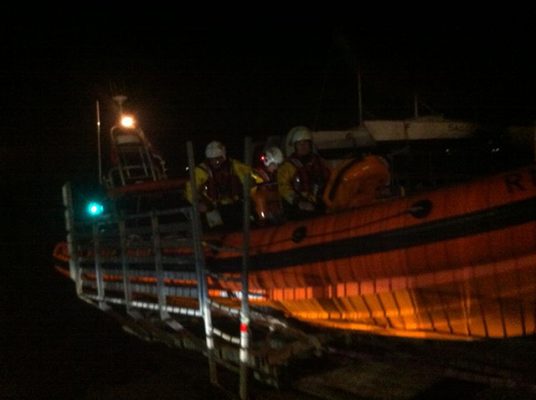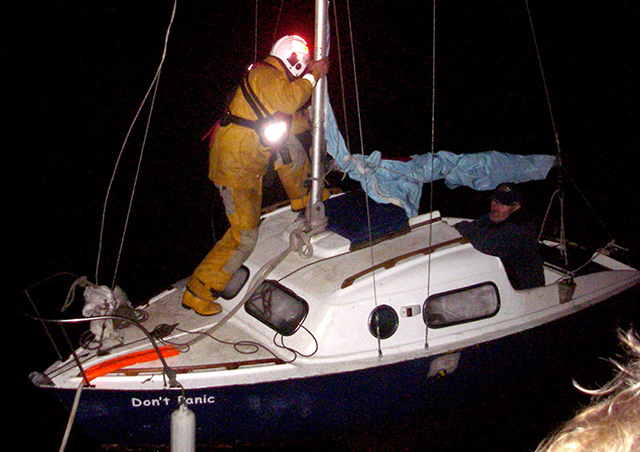A yacht that suffered a complete night-time power failure in the Solent’s shipping lane led to the urgent launching of Cowes RNLI lifeboat.
The 26ft Iszare had suffered the potentially dangerous break-down between Osborne Bay and Fishbourne, near Peel Bank, on Saturday evening.
The single-handed sailor aboard found he had no power, lights or VHF radio after several abortive attempts to start the boat’s engine.
The man, who had been sailing from Southampton to Hayling Island, anxiously alerted HM Coastguards of his plight via his mobile phone.
When close to the casualty the lifeboat was able to talk to the owner by virtue of the coastguard making a connect call which enables the lifeboat to speak on its marine VHF direct to the yacht skipper’s mobile phone.
A spokesman for Cowes RNLI Lifeboat station said: ‘News of an unlit yacht drifting in the shipping lane particularly concerned Southampton’s port authority because of the impending arrival in the area of a large ship.
‘The lifeboat launched at 8pm and managed to locate the yacht through lifeboat crew member Anne Simkin picking out its silhouette against the illuminated Ryde Pier further to the east.
‘After the yacht was towed to Trinity Landing, Cowes, the lifeboat returned to station at 9.15pm.’
Always be prepared before you set out to sea
The Coastguard has issued a reminder for seafarers to ‘invest in the correct communications equipment’ after three separate incidents of boats getting lost in the fog on the North East coast.
On Saturday afternoon, Humber Coastguard Operations Centre was alerted to three separate angling vessels, all lost in the fog, within the Humber estuary.
All vessels were safely returned to shore with the assistance of Humber and Cleethorpes Lifeboats alongside Cleethorpes and Donna Nook Coastguard Rescue Teams.
Senior Maritime Operations Officer Steve Cox from the UK Coastguard said: ‘We highly recommend anyone going out to sea should invest in the correct communications equipment including a fixed DSC VHF radio, a back-up VHF radio and ideally some sort of distress beacon.
‘Weather conditions can change in an instant, always check the weather and tidal conditions before you set out so that you can prepare accordingly.
‘If fog is forecast, poor visibility could obscure your safe return to the shore. Carry a compass, chart and GPS in case the visibility deteriorates. Aerosol fog horns are also available and might be useful if others are nearby or are looking for you.
‘To help us in locating you, should you get into difficulty, consider joining the MCA’s voluntary CG66 safety identification scheme. Always tell someone where you are going and when you expect to return and remember to update them if your plans change.’
Yacht rescue prompts reminder to carry VHF radio at sea
Don't rely on a mobile phone, says RNLI coxswain Mark Kenyon: Without a radio bearing 'a small vessel in rough…
Nav in a nutshell: Navigating at night
There’s no need to be in the dark if your preparation is thorough and easy to understand, says Dick Everitt…
‘Don’t Panic’ yacht rescue sparks safety warning
A small yacht without lights, VHF radio, GPS or flares was located by radar and mobile phone light after suffering…
Warning not to use LED bulbs in filament bulb navigation lights
Replacing filament bulbs with white LEDs in tricolour navigational lights could result in vessels not being insured, the Cruising Association…
‘Having a DSC radio on board and knowing how to use it could save your life’
'If you use Digital Selective Calling (DSC) radio correctly we will be able to locate you within moments', say UK…
Suspended sentence for night fisherman without nav lights
The boat owner 'repeatedly flouted regulations for commercial gain'
Night sinking for yacht
Couple rescued by Swanage RNLI
AIS across the Channel
PBO’s Sarah Norbury tried out AIS on a summer cruise to Brittany. Did it make crossing the shipping lanes any…
Make your intentions clear
Whether racing round the cans or crossing a shipping lane
Collision avoidance software
Ben Meakins puts Raymarine’s new Lighthouse AIS update through its paces in Southampton Water
Sailing cross-Channel in a Laser Pico
Charity challenger Dave Birch has completed a 75-mile cross-Channel sail from Guernsey to Torquay in a Laser Pico dinghy.
How to set up an astern tow at sea
We examine the techniques of towing and setting up an astern tow at sea, trying out the textbook theories in…















